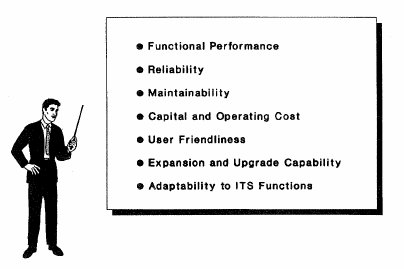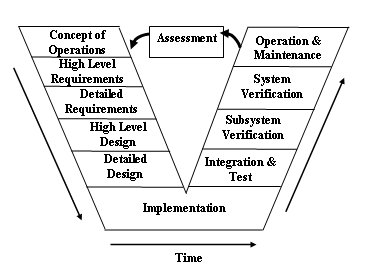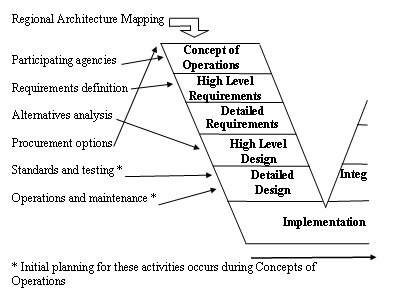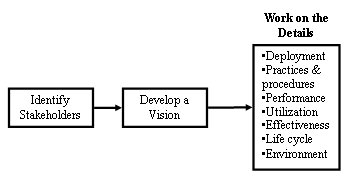Traffic Control Systems Handbook: Chapter 11. Selection of a System

Figure 11-1. Selection of a System
11.1 Introduction
The processes of defining system requirements, design, implementation, operation and management of a traffic control system are system engineering processes and are covered in this chapter as well as Chapters 12 and 13.
In recent years there has been an increased interest in applying systems engineering techniques to ITS. For example, the National Highway Institute offers the course "Introduction to System Engineering for Advanced Transportation" (1). Gordon (2) provides an overview of how system engineering processes have been applied to traffic signal systems and provides a number of references for these processes.
A system selection process encourages the objective consideration of alternatives in a structured, rather than subjective, manner. Further, the structured decision approach can generate a sense of commitment to the choice among system stakeholders including:
- Participating agencies,
- Traffic system engineers, and
- The driving public.
11.2 Federal-Aid Requirements
Federal aid often provides a portion of the resources used to implement traffic control systems. Particular attention should be paid to the following sections of Title 23 of the Code of Federal Regulations (CFR).
- Part 655 (Traffic Operations), Subpart D (Traffic Surveillance and Control), Section 655.409 (Traffic Engineering Analysis).
- Part 655 (Traffic Operations), Subpart F (Traffic Control Devices on Federal-Aid and Other Streets and Highways), Section 655.6-7 (Funding).
- Part 940 (Intelligent Transportation System Architecture and Standards), Section 940.11 (Project Implementation).
Part 940 defines the manner in which the systems engineering process will be applied to the project. The identified systems engineering practices include the following:
- Identify the portion of the regional architecture being implemented.
- Identification of participating agencies.
- Definition of requirements.
- Analysis of alternatives.
- Procurement options.
- Standards and testing procedures.
- Resources for operations and maintenance.
11.3 Systems Engineering and System Selection Process
System selection comprises the first three steps in the "V" representation of the systems engineering life cycle shown in Figure 11-2 (1). Most of the traffic signal systems installed are largely based on suppliers' existing software. Traffic controllers are similarly based on existing equipment and software. Modifications may be made to incorporate the special function, interfaces and data transfers that may be revised by the project. The relationship of the system engineering practices identified in Section 11.2 to the V diagram is shown in Figure 11-3 (1). The following subsections describe the first three steps of the "V" diagram:

Figure 11-2. "V" Representation of the Systems Engineering Life Cycle

Figure 11-3 Relationship of System Engineering Practices Identified in Part 940 to the System Engineering Life Cycle
Concept of Operations
The concept of operations is a document that defines the environment in which the system is to operate (1). The environment includes the relationship between the system and the agency's responsibilities, the physical environment, and expectations (performance and life). It:
- Describes the system's operational characteristics,
- Facilities understanding of goals,
- Forms the basis for long range planning,
- Presents an integrated view of the stakeholder organization and mission.
A general process for developing the concept of operations is shown in Figure 11-4 (1).
Performance measures to express the system's capabilities should be defined during the development of the concept of operations. These performance measures will be used during the entire systems engineering life cycle.
The documentation for the concept of operations should contain the following:
- Scope
- Referenced documentation
- Current system or situation
- Justification for and nature of changes
- Concepts for the proposed system
- Operational scenarios
- Summary of impacts
- Analysis of proposed system

Figure 11-4. Developing the Concept of Operations.
Requirements
Requirements are statements of what a system should do, when it should do it, and for whom. They do not define the manner in which the system should do it (1).
Two types of requirements are discussed below, end product requirements and functional requirements.
End product requirements define the needed system capabilities. These commonly include:
- Functional requirements (what capabilities the system will provide to the operator). These may include required modifications and traffic responsive requirements.
- Performance requirements. These typically include the number of intersections serviced, number of detectors processed, number of subnetworks accommodated and special data processing requirements.
- Interface requirements (identification of the systems to be connected with and the data flows. These requirements are closely related to the Regional ITS Architecture.
Enabling requirements identify what needs to be provided in order for the system to be compatible with the organizational and environmental circumstances. Examples include:
- Development (includes special functions or other requirements).
- Deployment (includes requirements to transfer from existing equipment to new equipment).
- Testing and support to assure proper functionality, reliability and robustness.
- Training to enable the operating agency to support the system.
1. "An Introduction to Systems Engineering for Advanced Transportation." National Highway Institute Course No. 137024, Publication No. FHWA-NHI-01-167, April 2003.
2. Gordon, R.L. "Systems Engineering Processes for Developing Traffic Signal Systems." NCHRP Synthesis 307, Transportation Research Board, Washington, DC, 2003.